Difficulty sleeping during the COVID-19 quarantine has become a common problem and can be manifested in a variety of ways; insomnia, fragmented sleep and nightmares. National prescription providers have reported a 21% increase in anti-insomnia, anti-anxiety and antidepressant medications since March of 2020. The past two weeks in Health & Exercise Forum” have been dedicated to sleep wellness.
We discussed the importance of sleep for health and wellness. Sleep is crucial to us as a species, but it is not always easily attained. For many individuals across the globe, sleeping properly can be a challenge. The trial and tribulations of the human experience can lead to restless nights and early morning risings without adequate sleep. This week, we will discuss how lack of quality or quantity of sleep can impact our lives in many ways and make suggestions to improve your sleep hygiene.
Although it may be tempting to sleep in on weekends after a long week of classes, some studies report that this habit results in a smaller volume of the gray matter of the brain in adolescents. Also, in this report, students who altered their sleep pattern on weekends had a lower grade average than those who did not. Therefore, it seems that it is not only important to maintain an average healthy average amount of sleep each night, but also to stay consistent with the hours that you are asleep.
There are many studies that have linked unhealthy sleep patterns to obesity. Inadequate sleep causes irregular levels of the hormones that are responsible for telling our brains when we need to eat. Therefore, this hormone imbalance can lead to obesity and thus make us vulnerable to the dangerous effects dramatically increased body fat.
A healthy sleep schedule has been shown to reduce the risk of heart disease and stroke, which are two of the leading causes of death in the United States. For example, interruptions in sleep due to disorders like sleep apnea have been shown to be a risk factor for stroke and that persistent tiredness often preceded heart disease.
Whether you are a high school or collegiate athlete, or simply enjoy some daily exercise, a healthy sleep schedule can help maximize performance. It is worth noting that it is possible that athletes require different sleep patterns than the general population to reach peak performance. Moreover, it has been shown that sleep loss is linked to a decreased ability in athletes to store sugar in the muscle to use as energy during a workout.
Needless to say, there are a plethora of things that can negatively impact our sleep. Even one night of poor sleep can drastically impact our performance and ability to concentrate the following day. So how do we combat this? There are several simple habits that can improve sleep hygiene and increase the likelihood of getting a good night’s sleep.
There are thousands of other resources that can help us achieve a great night’s sleep. Apps like “Calm” and “Headspace” have guided meditations and relaxation techniques to help us unwind before bed. More useful information about healthy sleep and why it is important can be found on Harvard Medical School’s Healthy Sleep website. And there are hundreds of thousands of YouTube videos with relaxation techniques and informative healthy sleep videos to be discovered. If these interventions do not improve your sleep, talk to your primary care doctor and see which next steps are right for you.
Sleeping well is not always easy and there will undoubtedly be nights on which rest eludes us despite our best efforts. But with consistent healthy sleep habits, we will be on our way to a healthier and better tomorrow.
For More Informations:
-http://healthysleep.med.harvard.edu/healthy/
-https://jamanetwork.com/journals/jamainternalmedicine/fullarticle/2110998
-https://www.sciencedirect.com/topics/medicine-and-dentistry/insomnia

Timothy Farrell, MD3
Tim Farrell is a third year medical student at Geisinger Commonwealth School of Medicine. Originally from Clarks Summit, Pennsylvania, Tim received his bachelor’s degree from Loyola University Maryland in Baltimore, MD. Currently a 2nd Lieutenant in the US Army, he enjoys listening to music, running, and spending time with his two dogs. He volunteers with the Cody Barrasse Foundation in the Organ Transplant Assistance Program, where he helps patients receive grant funding as they await their transplant surgery. He hopes to pursue a career in General Surgery.
This article is not intended as a substitute for medical treatment. If you have questions related to your medical condition, please contact your family physician. For further inquires related to this topic email: drpmackarey@msn.com
Paul J. Mackarey PT, DHSc, OCS is a Doctor in Health Sciences specializing in orthopaedic and sports physical therapy. Dr. Mackarey is in private practice and is an associate professor of clinical medicine at Geisinger Commonwealth School of Medicine.
Guest Columnist: Catherine Udomsak, DPT

Patients frequently ask me about the merits of yoga, from relaxation to flexibility. Many say, they are too busy or they don’t know enough about it. Well, in light of the fact that everyone has been forced to spend more time indoors, slow down and try new things, now may be a good time to try yoga.
It is hard to believe that yoga, which is now a cultural mainstay, was once considered a foreign practice. An ancient discipline that totes numerous health benefits, yoga is meant to cultivate inner peace, enlightenment, and a strong relaxed body. In the past, only major cities housed yoga studios but over time yoga has spread into small towns across the country. Studios offer a variety of classes and each promotes their own unique philosophy. Whether you are looking for a new workout regime, compliment to your current program or simply to quiet your mind in a hectic world, yoga may be an option for you.
Yoga is a discipline that developed over 5,000 years ago and is generally recognized as an ancient system for wellbeing. The word yoga, from the Sanskrit word “yuj”, literally means to yoke or to bind together. The primary focus of yoga is to harmonize or unite the mind, body, and spirit through a combination of poses, breathing techniques, and meditation.
The specific origin of yoga is a topic of debate. However, it is said to have originated in India and was brought to the Western world by yoga gurus in the late 19th and early 20th centuries. The basis for most current yoga practices is The Yoga Sutras of Patanjali. In The Yoga Sutras, eight limbs of yoga are specified. The three most common limbs are meditation, pranayama or breathing exercises, and asana which are the physical poses. Yoga classes can vary greatly, however, most classes include a combination of meditation, breathing exercises, and physical postures.
There are numerous styles of yoga. If you are a newcomer, deciding on a yoga class may be difficult. It is always a smart idea to call a studio before attending a class to gain information and have any questions answered. Furthermore, if you have any health concerns you may want to consult your doctor prior to trying a new form of exercise. Some common forms of yoga include but are not limited to:
Hatha - Hatha yoga is a general broad-based term referring to any type of yoga that teaches physical postures. Typically, one will find Hatha classes to be slow and gentle and a great option for beginners.
Vinyasa - This type of yoga focuses on the coordination of breath with movement. In Vinyassa yoga classes you can expect a continuous flow of movement from one posture to the next. Classes can be fast paced and are often appealing to those looking for a more strenuous workout.
Iyengar - Unlike Vinyassa, this type of yoga focuses on holding postures for a period of time to bring the body into it’s best alignment. If you attend this type of yoga class you can expect to use props including yoga blocks, blankets, and straps.
Ashtanga - This type of yoga follows a specific sequencing of postures. This rigorous form of yoga always performs the same postures, in the same order at each class and is typically fast paced.
Bikram - Typically performed in rooms heated to 105 degrees Fahrenheit and 40% humidity, the heat warms muscles and allows a deeper stretch. The difference between Bikram and Hot yoga is that Bikram follows a specific sequence of 26 poses from which hot yoga often deviates.
Yin Yoga - This meditative practice is perfect for those who want to calm their mind. In this type of yoga, poses are held for 5 minutes or longer. The purpose is to apply a deep stretch to the connective tissue (the tendons, fascia and ligaments) to improve flexibility.
Restorative - Best for those who want to focus on relaxing and taking some time to slow down. Most restorative yoga classes will be slow moving with longer hold times to allow deep relaxation.
Below you can find a few common yoga poses or asanas that can be found in beginner classes. These poses promote flexibility and strength and can be incorporated into your everyday workout routine. Remember, before you attempt the poses, begin by walking, biking or running to warm up. Don’t overstretch, perform slowly, and hold the position. You should feel mild discomfort NOT pain.
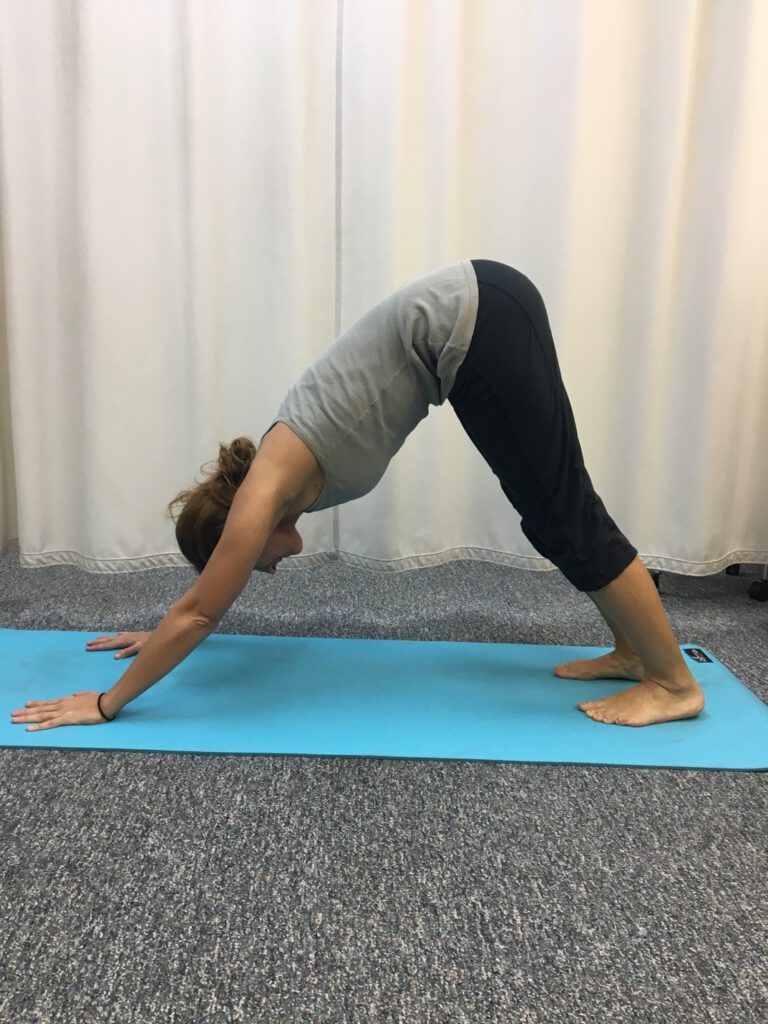
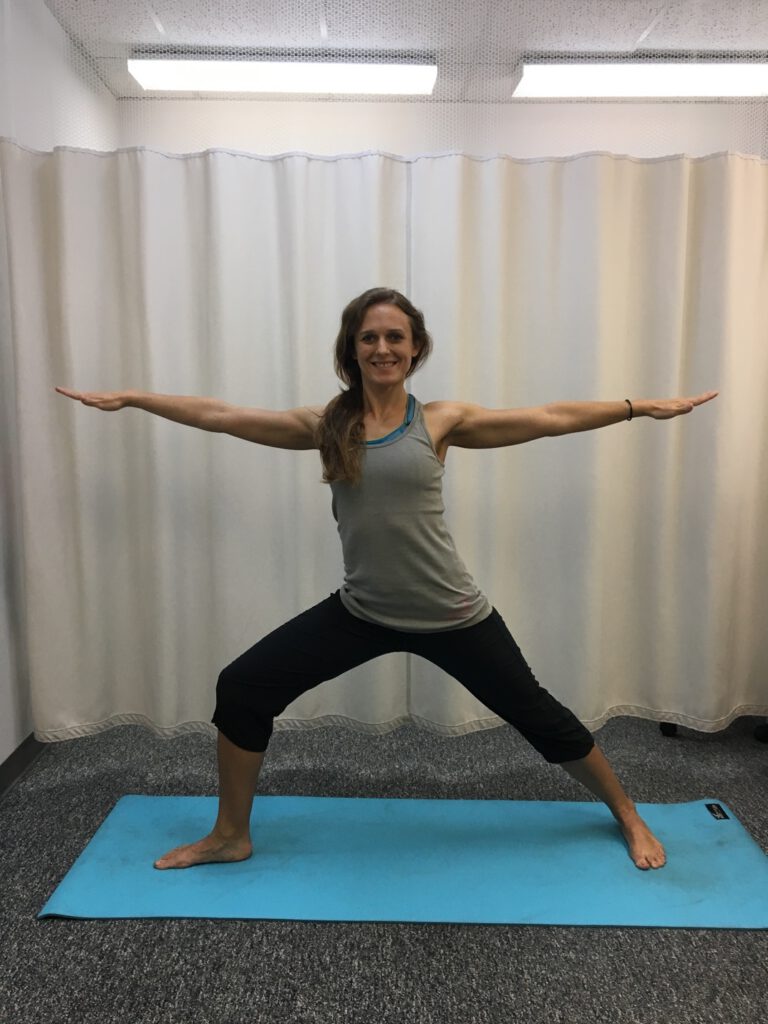
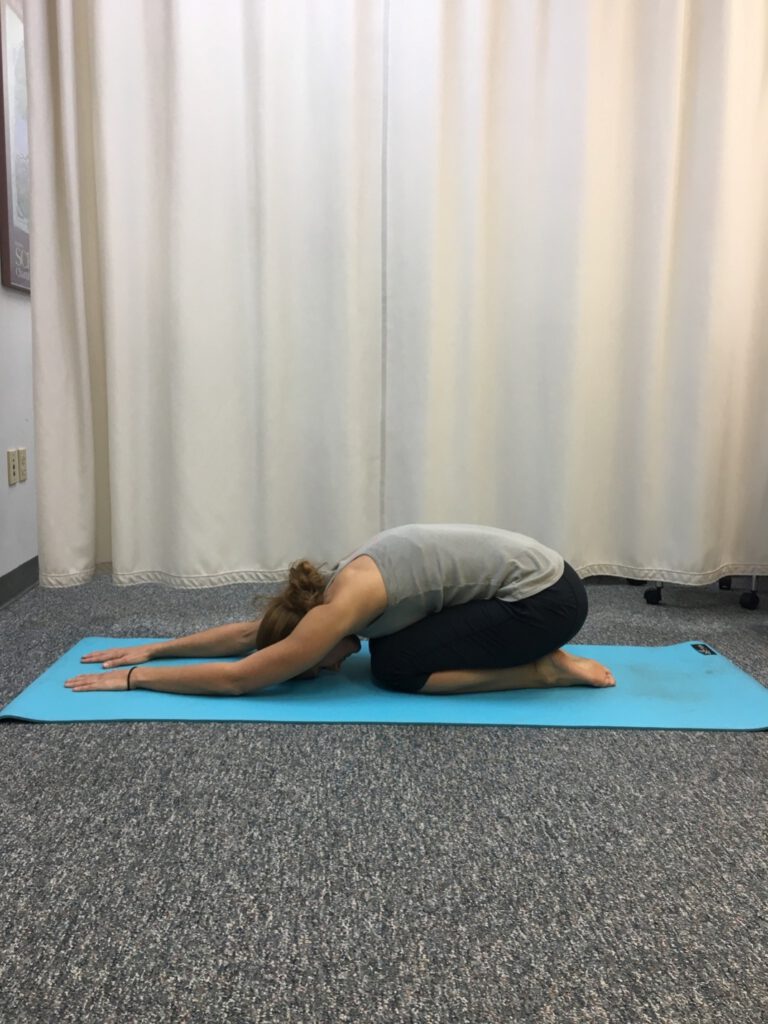
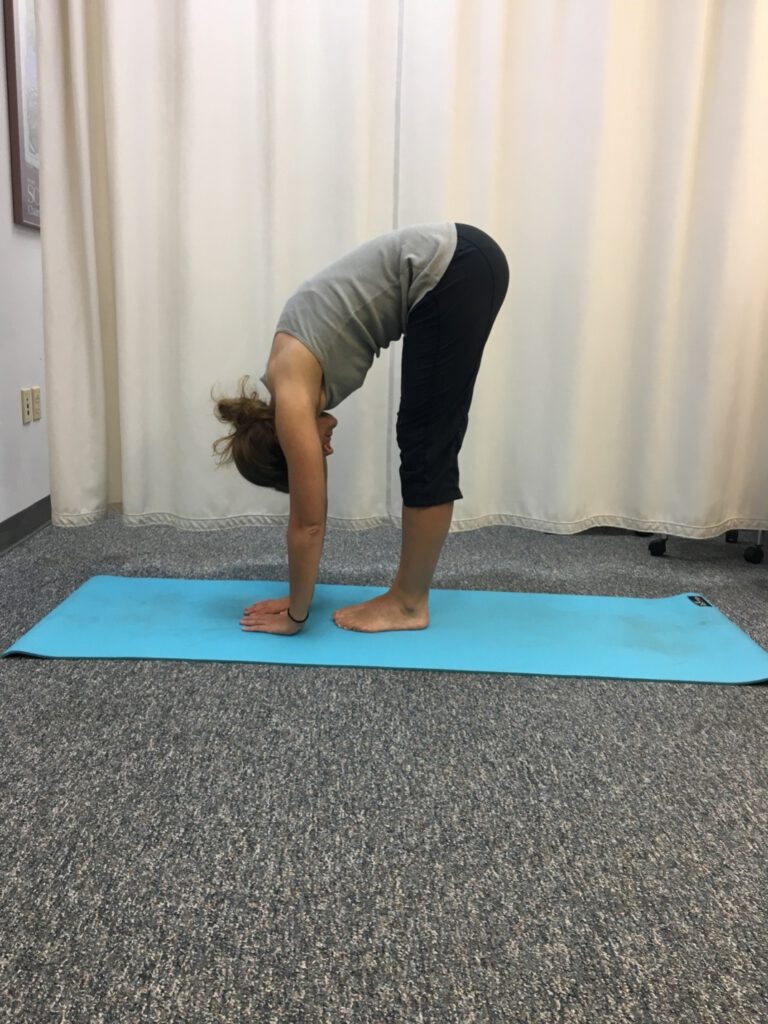
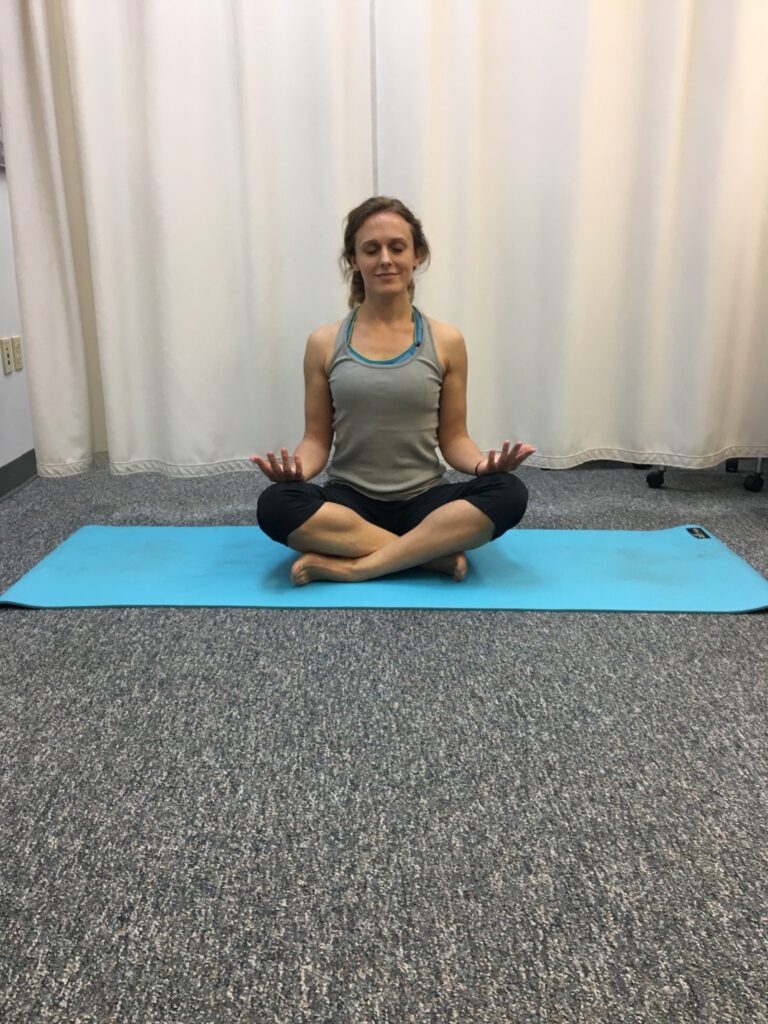
There are a lot of options when it comes to where to start to practice yoga. It is important that the studio you choose employs certified yoga instructors who have completed comprehensive training. A good instructor can make all the difference in your yoga experience. The studio should provide a clean environment and offer a variety of classes including beginner level if you are a newcomer. The best way to get a feel for a studio is to stop in for more information. You may want to ask about pricing as there are often discount introductory rates. Ask about rentals if you do not own a yoga mat and request to see the space. Some yoga studios have a strong sense of community while others are more like a gym. Try out a few different places until you find a fit for you.
Guest Columnist: Catherine Heimrich, DPT is a doctor of physical therapy and is an associate at Mackarey & Mackarey Physical Therapy Consultants, LLC in downtown Scranton, where she works with outpatient orthopedic and neurological patients. She has a special interest in vestibular and balance problems.
Model: Sarah Singer, PTA
Read Dr. Mackarey’s "Health & Exercise Forum" every Monday in the Scranton Times-Tribune.
This article is not intended as a substitute for medical treatment. If you have questions related to your medical condition, please contact your family physician. For further inquires related to this topic email: drpmackarey@msn.com
Paul J. Mackarey PT, DHSc, OCS is a Doctor in Health Sciences specializing in orthopaedic and sports physical therapy. Dr. Mackarey is in private practice and is an associate professor of clinical medicine at Geisinger Commonwealth School of Medicine.

Yoga for a Healthy Mind, Body, and Spirit, Part 1 of 2
Guest Columnist: Catherine Heimrich, DPT
Patients frequently ask me about the merits of yoga, from relaxation to flexibility. Many say, they are too busy or they don’t know enough about it. Well, in light of the fact that everyone has been forced to spend more time indoors, slow down and try new things, now may be a good time to try yoga.
It is hard to believe that yoga, which is now a cultural mainstay, was once considered a foreign practice. An ancient discipline that totes numerous health benefits, yoga is meant to cultivate inner peace, enlightenment, and a strong relaxed body. In the past, only major cities housed yoga studios but over time yoga has spread into small towns across the country. Studios offer a variety of classes and each promotes their own unique philosophy. Whether you are looking for a new workout regime, compliment to your current program or simply to quiet your mind in a hectic world, yoga may be an option for you.
Yoga is a discipline that developed over 5,000 years ago and is generally recognized as an ancient system for wellbeing. The word yoga, from the Sanskrit word “yuj”, literally means to yoke or to bind together. The primary focus of yoga is to harmonize or unite the mind, body, and spirit through a combination of poses, breathing techniques, and meditation.
The specific origin of yoga is a topic of debate. However, it is said to have originated in India and was brought to the Western world by yoga gurus in the late 19th and early 20th centuries. The basis for most current yoga practices is The Yoga Sutras of Patanjali. In The Yoga Sutras, eight limbs of yoga are specified. The three most common limbs are meditation, pranayama or breathing exercises, and asana which are the physical poses. Yoga classes can vary greatly, however, most classes include a combination of meditation, breathing exercises, and physical postures.
So what is with all the hype? Why has yoga become so popular? Many would say it is due to its numerous mental and physical health benefits. Research has shown that yoga, when practiced regularly, can reduces stress levels and even boost one’s immune system. Regular stretching releases tension in the body and the controlled breathing and mediation decrease anxiety. Studies show that those who practice yoga habitually can have decreased blood pressure and cholesterol making them less prone to heart disease. Other ailments which are shown to be positively impacted by yoga include insomnia, depression, and chronic pain including low back pain and headaches. Yoga is an excellent way to combat the negative effects of stress on the body and cope with anxiety and angst.
In addition to stress reduction, yoga has many physical benefits. These include increased flexibility, strength, and balance. Those who practice yoga regularly are often less prone to injury, such as a muscle strain or tear, due to their increased flexibility. Furthermore, yoga can be an effective way to strengthen one’s core which is crucial to maintaining ideal posture and protecting the back. For athletes, yoga can be a great way to challenge one’s balance and improve stability. In the elderly, it is a safe way to improve overall body awareness and decrease the risk of falling. Yoga has also been shown to improve respiration and many report an overall increase in energy when incorporating yoga into their lives.
With all of the positive impacts yoga has on the body it is easy to see why it has become such a popular form of exercise. There are classes to meet almost all needs and most poses can be modified based on ability. Yoga can be practiced by those of all ages and all fitness levels. Whether you’re looking for a way to loosen up tight muscles or you simply wish to quiet your mind for an hour, yoga is a tool to improve and maintain health. The only thing you need is a mat and an open mind.
Yoga can be practiced by anyone. From children to adults to the elderly, there are classes for all ages and abilities. It can be a form of cross training for athletes, especially runners who tend to have tight musculature. It also promotes balance and core stability which may be beneficial to sportspersons including football players, soccer players, boxers, etc. Furthermore, there are classes for the elderly which focus on balance and maintaining mobility. There are even prenatal yoga classes for pregnant women to promote deep breathing, flexibility and muscle tone.
Next Week: Types of Yoga and Basic Poses
Guest Columnist: Catherine Heimrich, DPT is a doctor of physical therapy and is an associate at Mackarey & Mackarey Physical Therapy Consultants, LLC in downtown Scranton, where she works with outpatient orthopedic and neurological patients. She has a special interest in vestibular and balance problems.
Read Dr. Mackarey’s "Health & Exercise Forum" in the Scranton Times-Tribune every Monday. Next Week: Yoga - Part 2
This article is not intended as a substitute for medical treatment. If you have questions related to your medical condition, please contact your family physician. For further inquires related to this topic email: drpmackarey@msn.com
Paul J. Mackarey PT, DHSc, OCS is a Doctor in Health Sciences specializing in orthopaedic and sports physical therapy. Dr. Mackarey is in private practice and is an associate professor of clinical medicine at Geisinger Commonwealth School of Medicine.

A healthy immune system may be the difference between recovery from illness and dying. While you may not be able to improve an otherwise healthy immune system, you can take steps to maintain its health and integrity. Exercise is one of the best ways to maintain a healthy immune system.
With the closing of fitness centers, school gyms and exercise classes due to COVID-19, it may be a good time to begin a home exercise program that is quick and easy. For some, home exercises can be done before or after working from home to gain or maintain muscle tone. For others, home exercises may help maintain independence and safety performing daily activities around the house such as; climbing stairs, getting in and out of a shower, putting on shoes and socks, cooking, cleaning, and carrying groceries or laundry.
I have comprised 10 simple exercises including upper and lower body and balance and core. The only equipment you will need is a chair and resistance bands; yellow has the least resistance, black the most, red, green, blue in between. They can be purchased at any sporting goods or department store.
Remember, for most people it is more harmful not to exercise, so contact your physician to discuss whether independent exercise is appropriate for you. If you have special needs, you may need to consult with a physical therapist to get started. Good luck…I hope this helps you survive the COVID-19 quarantine!
These exercises are performed while sitting in a chair with a backrest, slowly. Hold the position for 3 seconds. Perform 5 -10 repetitions. Do these exercises 3-5 times per week. Begin with a yellow light resistance band.
Row the Boat (PHOTO 1)
Saw Wood (Photo 2)
Elbow Extension (Photo 3)
Hip Spread (Photo 4)
Hip Hike (Photo 5)
Leg Kicks (Photo 6)

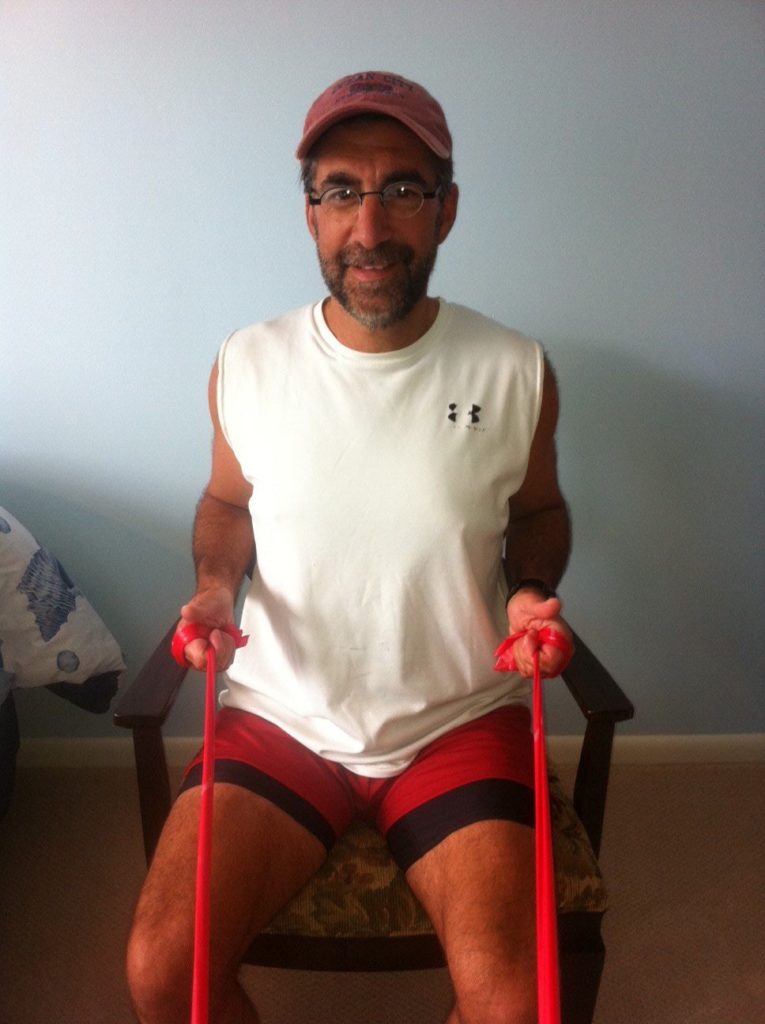
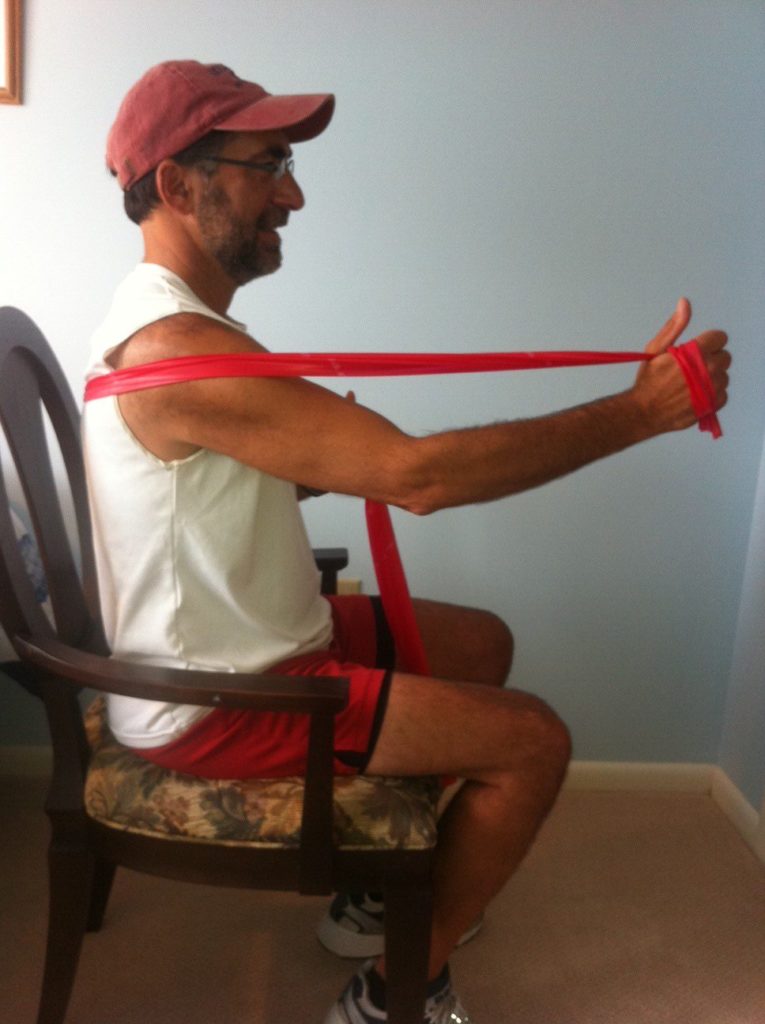
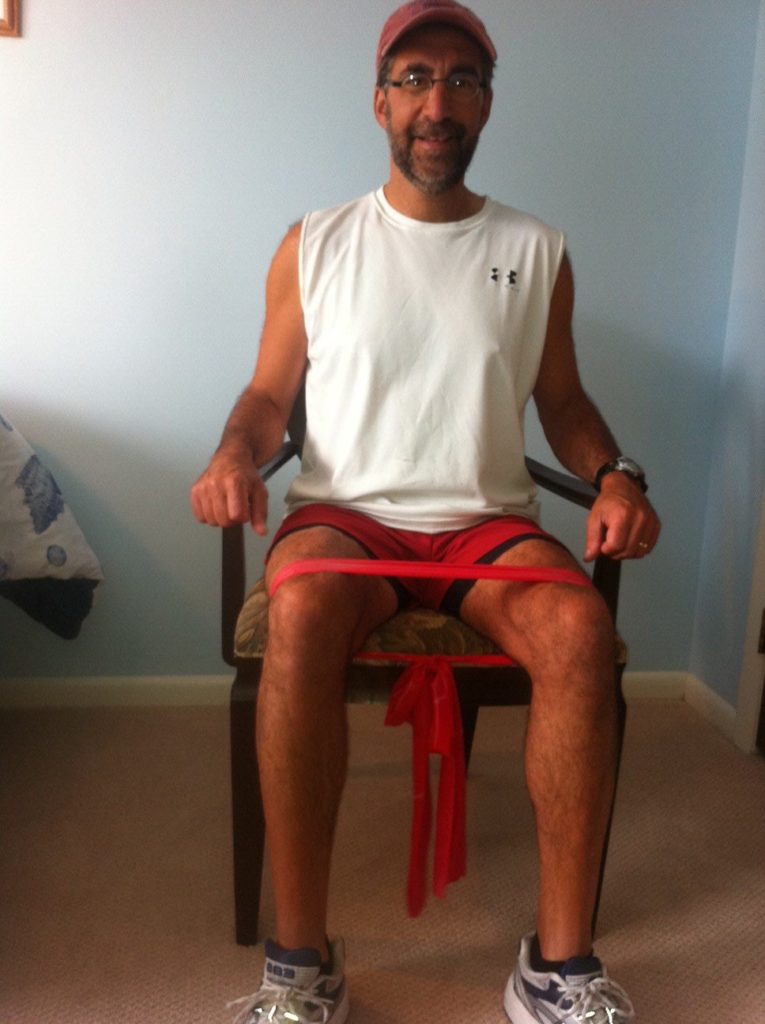
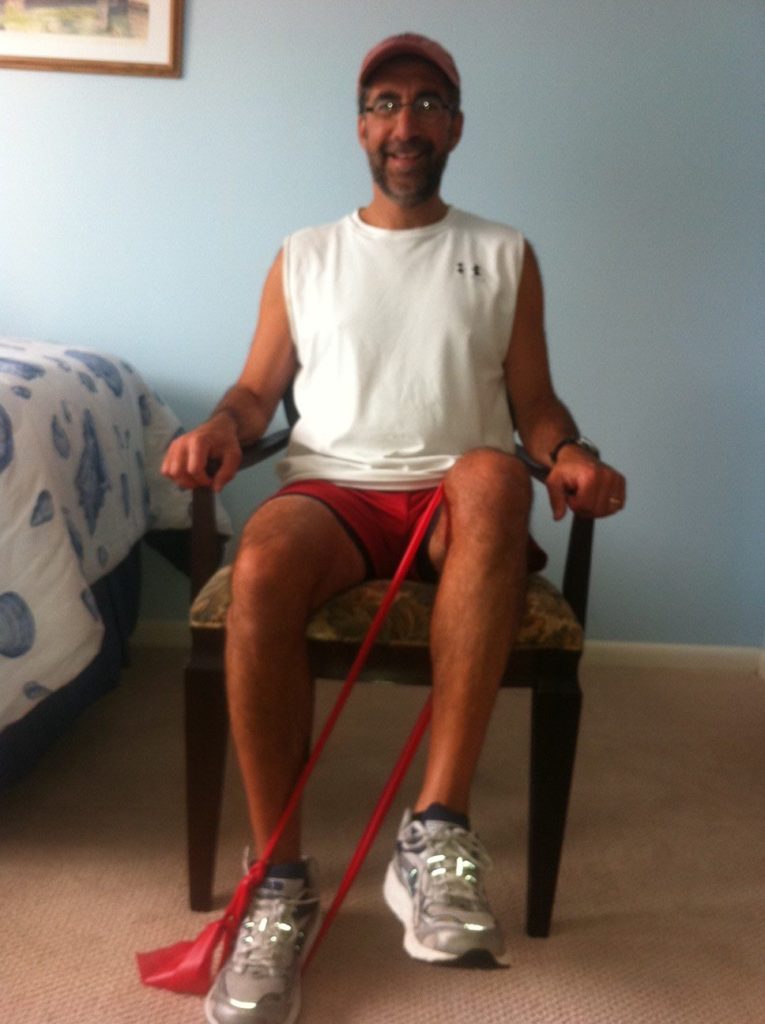
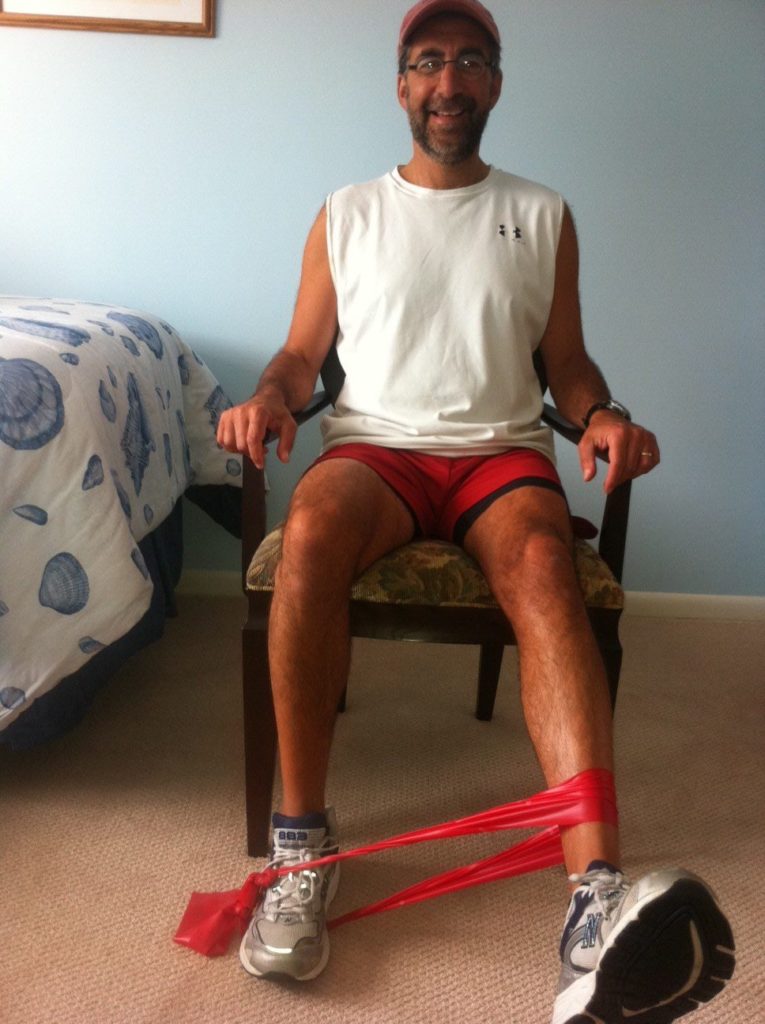
Shoulder Shrug (Photo 7)
Elbow Bend (Photo 8)
Standing Leg Curl (Photo 9)
Standing Walk Aways - Backward (Photo 10)
Standing Walk Aways - Forward
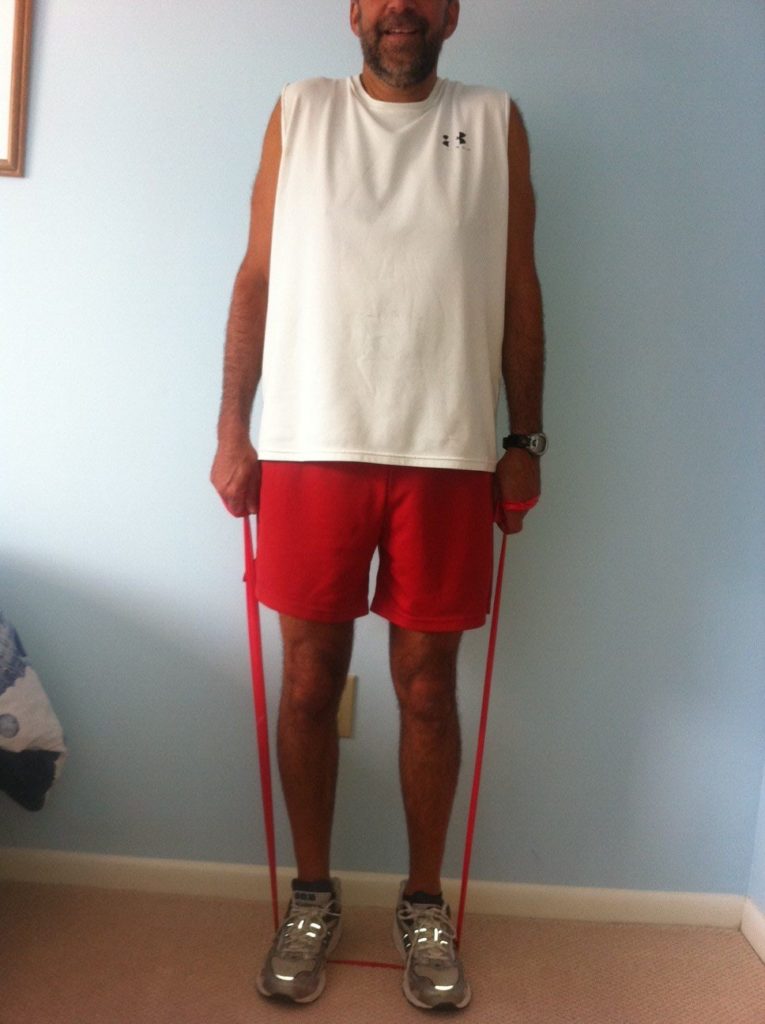
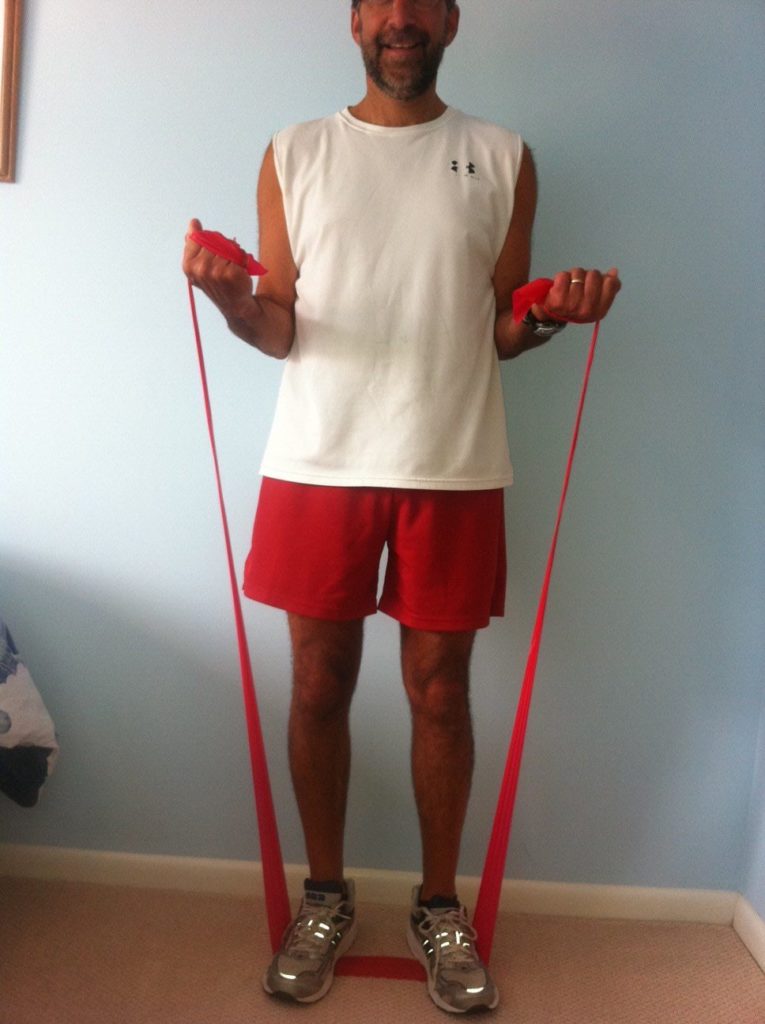
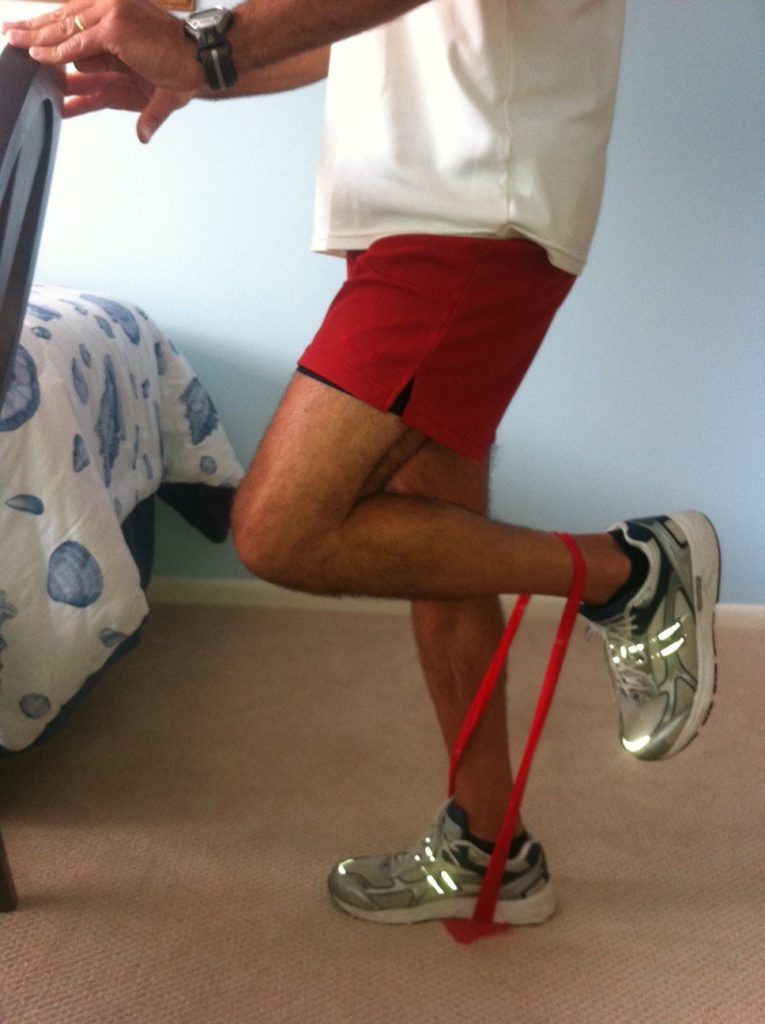
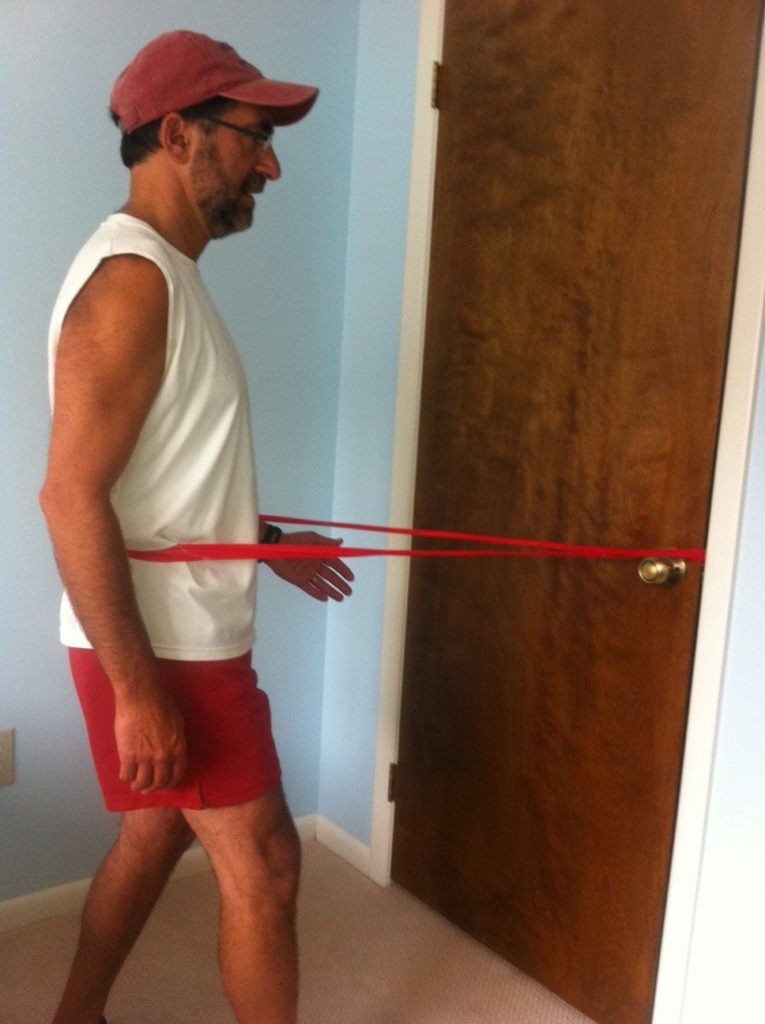
Visit your doctor regularly and listen to your body.
Keep moving, eat healthy foods, exercise regularly, and live long and well!
Read Dr. Mackarey’s "Health & Exercise Forum" every Monday in the Scranton Times-Tribune.
This article is not intended as a substitute for medical treatment. If you have questions related to your medical condition, please contact your family physician. For further inquires related to this topic email: drpmackarey@msn.com
Paul J. Mackarey PT, DHSc, OCS is a Doctor in Health Sciences specializing in orthopaedic and sports physical therapy. Dr. Mackarey is in private practice and is an associate professor of clinical medicine at Geisinger Commonwealth School of Medicine.